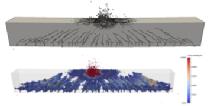

News & Events
Invited talk: The Lattice Discrete Particle Model (LDPM): From Concrete Micro-Structure to Structural Modeling of High Impulsive Loading Events
Time: 2014/10/9, 9:00,
Location: Civil Engineering B504
Chairs:
Benliang Liang, Associate Professor
Peizhen Li, Associate Professor
SEMINAR 1
The Lattice Discrete Particle Model (LDPM): From Concrete Micro-Structure to Structural Modeling of High Impulsive Loading Events In this presentation the Lattice Discrete Particle Model (LDPM) for concrete will be discussed. LDPM is a discretemesoscale model of concrete that can accurately describe the macroscopic behavior of concrete during elastic, fracturing, softening, and hardening regimes. LDPM has been calibrated and validated extensively through the analysis of a large variety of experimental tests. LDPM can reproduce with great accuracy the response of concrete underuniaxial and multiaxial stress states in both compression and tension and under both quasi-static and dynamic loading conditions. The LDPM technology has been proven to supersede by far most of other available computational techniques for the simulation of concrete, especially for applications where the description of material internal structure and the link among different length scales is important. The LDPM formulation is obtained by modeling the interaction among coarse meso-scale aggregate pieces as the interaction among polyhedral cells (each containing one aggregate piece) whose external surfaces are defined by sets of triangular facets. At each facet strain and stress, vectors are used to formulate the constitutive law describing physical mechanisms such as tensile fracture, cohesion, friction, etc. In a similar discrete fashion, the effect of fiber reinforcement can also be taken into account. The presentation will give an overview of recent successes of the LDPM technology and the development of a multiscale/multiphysics framework that use LDPM as the main fundamental component. The use of these novel approaches is demonstrated in relation to a variety of applications spanning several different themes from infrastructure aging and deterioration (Fig. 1a) to the response of structures subjected to highly dynamic and impact loading (Fig. 1b, c).



(a) (b) (c)
Fig. 1: (a) ASR deterioration of concrete. (b) Projectile penetration. (c) Fragmentation due to blast loading.
SEMINAR 2
MARS – Modeling and Analysis of the Response of Structures (http://mars.es3inc.com/)
This presentation will discuss the main capabilities of the computational software MARS, especially with reference to unique methods for the simulation of failure and break-up of structures. MARS is a powerful and robust object-oriented computational program for simulating the mechanical response of structural systems subjected to short duration loading events. It is based on a dynamic explicit algorithm and features all the capabilities of a general finite element code. In addition, MARS implements some unique techniques, such as the Lattice Discrete Particle Method (LDPM) and adaptive remeshing algorithms for shell and solid meshes.
These algorithms facilitate the solution of problems involving structural break-ups, fragmentation and post-failure response. MARS, thanks to its OO architecture, makes it possible to add new capabilities in an efficient and systematic fashion. All entities in MARS are organized in a hierarchical framework. Classes of simple entities, such as edges and faces, are used to derive more complex entities, such as beams and shells. MARS has been
successfully adopted for the simulation of a wide variety of problems, which include: (a) laceration of plates and shells; (b) response of reinforced concrete structures to blast loads and fragment impacts; (c) fragmentation of ordinance casings; and (d) cable dynamics problems.




(a) (b) (c) (d)
About the Speaker
Prof. Gianluca Cusatis is a faculty member of the Civil and Environmental Engineering Department at NorthwesternUniversity that he joined in August 2011. Previously, he worked at Rensselaer Polytechnic Institute for six years (2005-2011). He teaches undergraduate and graduate courses of the civil engineering curriculum and performs research in the field of Mechanics of Quasi-Brittle Materials.Gianluca’s alma mater is the Politecnico di Milano (Milan, Italy) where he worked in the research group of Prof. Luigi Cedolin.
He obtained his “Laurea” degree in 1998, with a thesis on the viscoelastic behavior of concrete subjected to variable temperature and humidity, and his PhD degree in 2002, with a dissertation dealing with mesoscale modeling of concrete.In the last fifteen years, he has been working in the field of computational and applied mechanics, with emphasis on heterogeneous and quasi-brittle materials, concrete and reinforced concrete
modeling. His work on constitutive modeling of concrete especially through the adoption of the so-called Lattice Discrete Particle Model (LDPM), one of the most accurate and reliable approaches to simulate failure of materials experiencing strain-softening, is well known. In addition, his research interests include: dynamic response of concrete; micro- and meso-mechanics; multiple scale mechanics; linear and nonlinear fracture mechanics; nonlinear constitutive modeling, concrete creep; rate effect on material strength; moisture and heat transfer; and concrete-steel interface behavior.Under the sponsorship of several agencies – including NSF, ERDC, DHS, and DTRA – his current research focuses on formulating and validating multiscale and multiphysics computational frameworks for the simulation of large scale problems dealing with a variety of different applications including, but not limited to, infrastructure aging and deterioration, structural resiliency, projectile penetration, and design of blast resistance structures. He is member of ASCE, ACI, and active in several technical committees. He chairs the ACI 446 committee on Fracture Mechanics where he is leading an effort to develop practical guidelines for the calibration and validation of concrete models.

